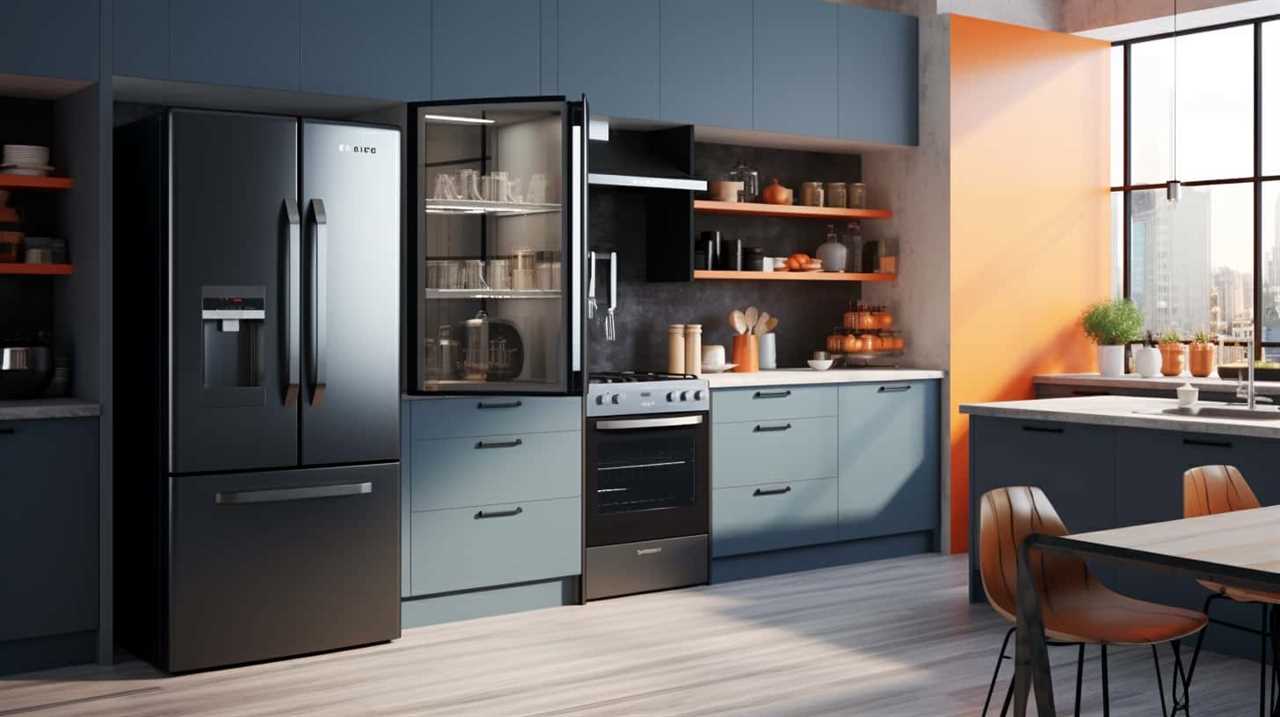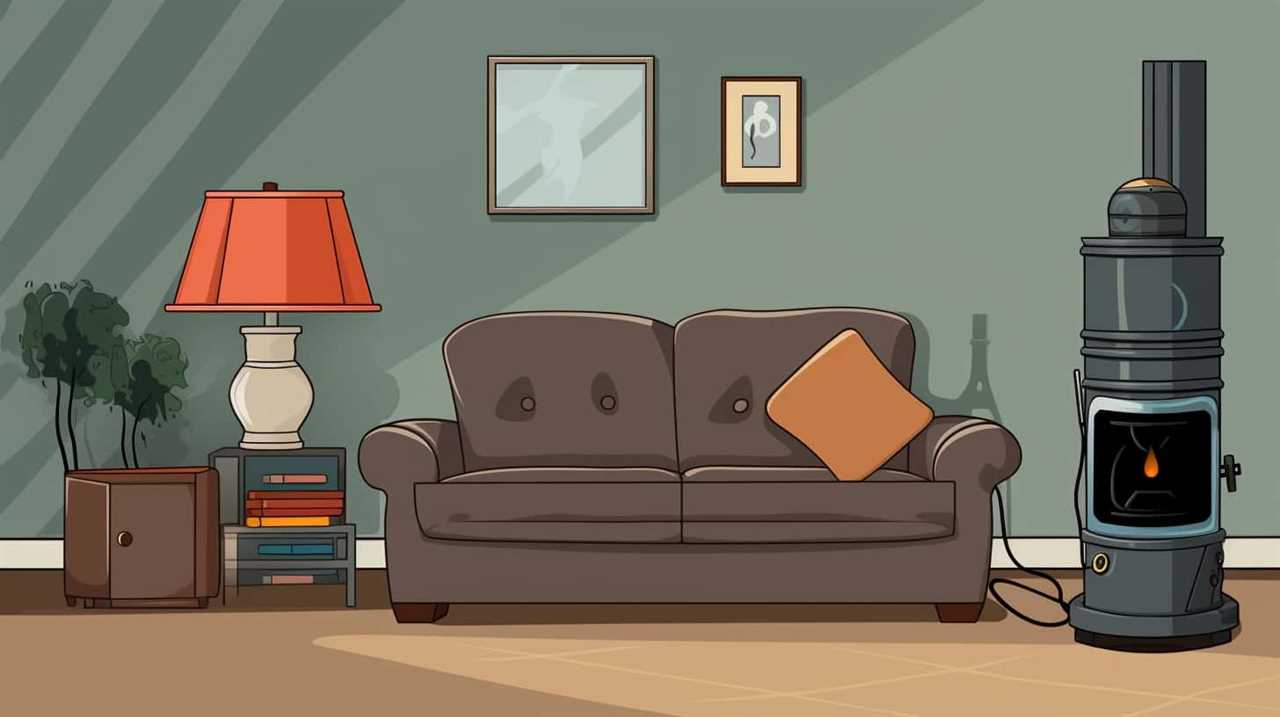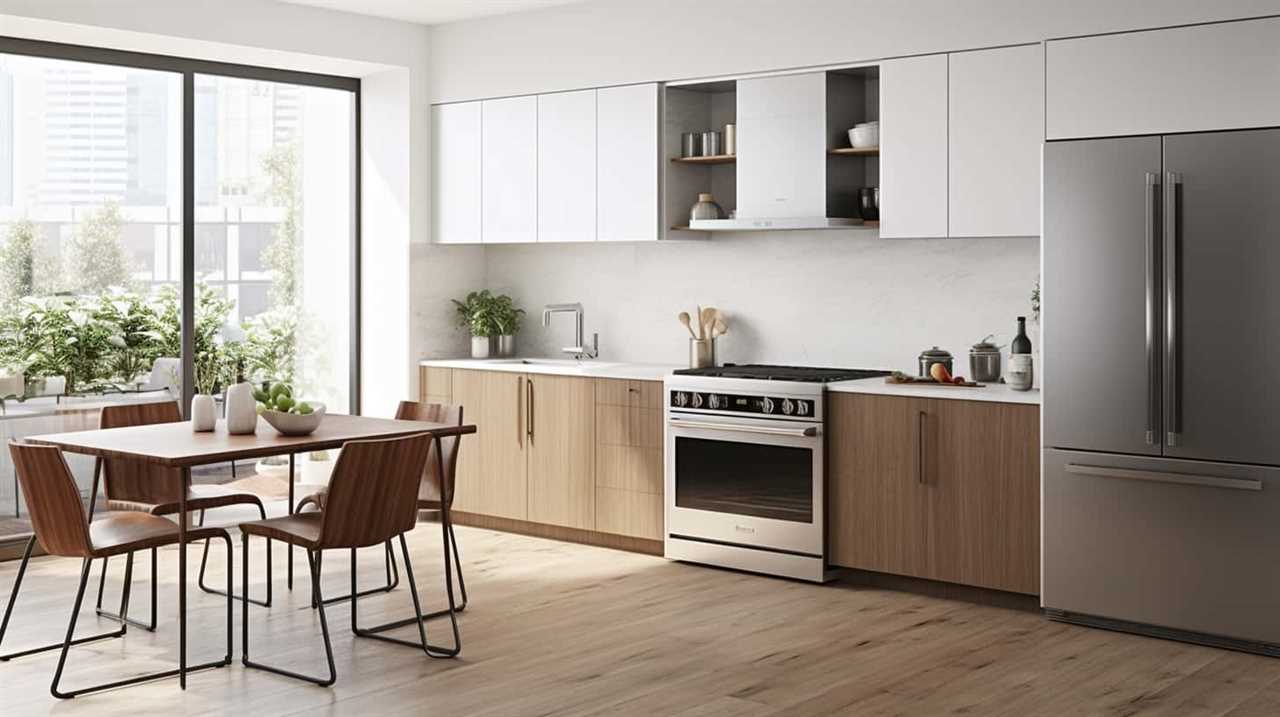Picking out the perfect range hood involves looking at your cooking style and kitchen size. If you use high-BTU appliances, go for a ducted hood to get top-notch airflow and efficiency. For smaller spaces, a ductless version could do the trick, but remember, you’ll need to change filters often. Keep an eye on the CFM rating—the higher, the better for proper ventilation. Don’t forget to think about styles and features that fit your kitchen’s look and your needs, such as adjustable fan speeds and built-in lighting. Excited to learn more tips and explore other choices? Stay tuned for valuable information coming your way!
Key Takeaways
- Determine if you need a ducted or ductless range hood based on your cooking intensity and kitchen layout.
- Calculate the required CFM based on your stove's BTU output for effective ventilation.
- Choose a hood style that fits your kitchen space, such as under-cabinet, wall-mounted, or island hoods.
- Consider additional features like adjustable fan speeds, built-in lighting, and smart technology for enhanced functionality.
- Regularly maintain filters and clean the hood to ensure optimal performance and air quality.
Importance of Range Hoods
When you cook, smoke, odors, and harmful particles can fill your kitchen, which is why range hoods are so important. They play a significant role in maintaining good indoor air quality by removing cooking fumes, grease, and humidity.
These powerful appliances either vent air outside or recirculate it through filters, effectively eliminating contaminants that can accumulate in your home. Proper ventilation in your kitchen is just as essential as maintaining your plumbing systems; both play important roles in creating a safe environment.
Regularly inspecting and cleaning your range hood can prevent clogged toilet solutions that stem from poor air quality.
Inadequate ventilation can lead to health risks, particularly in homes with better insulation and high-BTU cooking appliances. The International Residential Code and the EPA recognize how fundamental proper ventilation is for your health and well-being.
By investing in a quality range hood, you reduce the risk of hazardous air buildup and create a healthier cooking environment.
Regular maintenance, including filter cleaning, is also critical for peak performance. Clogged filters can hinder a range hood's ability to capture harmful particles and expel cooking fumes effectively.
So, keeping your range hood in tip-top shape guarantees it continues to enhance your kitchen's air quality, making your cooking experience safer and more enjoyable.
Don't underestimate the importance of these appliances—they're key to a healthier home.
Types of Range Hoods

When it comes to choosing a range hood, you'll encounter both ducted and ductless options, each with its own benefits.
Ducted range hoods are typically more effective at removing smoke and odors, making them ideal for heavy cooking.
You'll also find a variety of styles, from under-cabinet to island hoods, that can enhance your kitchen's look and functionality.
Understanding these different types will help you make the best choice for your cooking needs, and considering factors like reputation and reviews from past clients can also guide your decision.
Ducted Vs. Ductless Options
Choosing between ducted and ductless range hoods can markedly impact your kitchen's cooking experience and air quality. Ducted range hoods are designed to expel smoke and odors outside through ductwork, making them ideal for heavy cooking. They offer higher airflow capacity, typically featuring higher CFM ratings, which is essential for high BTU stoves. On the other hand, ductless range hoods recirculate air back into your kitchen using filters, making them easier to install and suitable for spaces without duct access.
Here's a quick comparison to help you decide:
| Feature | Ducted Range Hoods | Ductless Range Hoods |
|---|---|---|
| Airflow Capacity | High CFM | Lower CFM |
| Installation | Requires ductwork | Easy, no duct needed |
| Efficiency | More efficient for heavy cooking | Limited efficiency, relies on filters |
| Filter Maintenance | Minimal (if any) | Frequent charcoal filter replacement |
Consider your cooking habits and kitchen layout when choosing between these options. If you cook often and intensely, ducted may be your best bet. For lighter cooking or limited space, a ductless hood could work well.
Range Hood Styles Explained
Range hood styles vary considerably, each designed to meet different kitchen needs and aesthetics. When you're planning a kitchen remodel, it's crucial to understand these options, much like selecting the perfect elements for a modern farmhouse bedroom to create a serene atmosphere.
- Under-Cabinet Hoods: Ideal for smaller kitchens, these economical hoods fit snugly beneath cabinets. Prices start around $50 for non-ducted models and range from $175 to $250 for ducted versions.
- Wall-Mounted Hoods: Installed directly against the wall, wall-mounted hoods suit traditional kitchen layouts. Expect to pay between $500 and $700 for mid-range options.
- Island Hoods: Suspended from the ceiling, island hoods are perfect for kitchens with cooking islands. Their larger size and aesthetic appeal come with a price tag of $1,200 to $2,500.
- Downdraft Hoods: These retractable hoods integrate into cooktops, preserving your kitchen's look. However, they're less effective for high-BTU cooking environments.
- Professional Hoods: Designed for heavy cooking, these high-performance models offer superior ventilation and are also available for residential use.
Choosing the right range hood style can enhance both functionality and design in your kitchen.
Ducted Vs. Ductless Options

When choosing between ducted and ductless range hoods, consider how efficiently each option removes air from your kitchen.
Ducted hoods are generally better for heavy cooking, as they effectively expel smoke and odors, making your kitchen a more pleasant space to cook in. Additionally, incorporating a serene atmosphere in your kitchen can enhance your overall cooking experience, similar to how a cottagecore home office creates a cozy workspace.
Meanwhile, ductless models offer easier installation for kitchens without duct access. Your cooking style and space will play a big role in determining which option is the right fit for you.
Efficiency of Air Removal
In the debate over air removal efficiency, ducted and ductless range hoods offer distinct advantages and disadvantages. Understanding these differences can help you make an informed choice for your kitchen. Properly evaluating your kitchen's needs can greatly influence your decision, as the right choice can lead to improved air quality and a more pleasant cooking environment.
Here are four key points to reflect on:
- Airflow: Ducted range hoods typically have higher CFM ratings, allowing for better airflow and faster removal of smoke, odors, and pollutants.
- Filters: Ductless models use dense carbon filters that require regular replacement, while ducted hoods generally need less frequent maintenance.
- Efficiency: Ducted range hoods expel air outside, making them more efficient in eliminating heat and humidity, especially in heavy cooking environments. This efficiency is somewhat akin to the high-pressure application of an airless paint sprayer, which atomizes paint for an even finish.
- Grease Buildup: With ducted hoods, you'll experience reduced grease buildup in your kitchen, leading to improved air quality.
If you're focused on superior efficiency and air removal, ducted range hoods are the way to go. They're designed to handle the demands of serious cooking, ensuring your kitchen stays fresh.
Conversely, if installation simplicity is a priority, ductless models can still provide adequate air purification, but may not meet high-performance standards.
Installation Requirements Comparison
Choosing between ducted and ductless range hoods involves understanding their installation requirements, which can greatly impact your kitchen setup.
Ducted range hoods require the installation of ductwork to vent air outside, making them more complex and often necessitating professional installation. You'll need to guarantee compliance with local building codes and pay attention to venting requirements. Typically, the installation height for ducted hoods should be between 24-30 inches above the cooking surface, and they usually require a minimum duct diameter of 6 inches, depending on the CFM rating.
Additionally, considering the energy efficiency of your range hood can help reduce long-term costs, similar to how pool heater efficiency ratings impact energy costs and performance.
On the other hand, ductless range hoods are easier to install since they recirculate air without needing external ducts. They also have similar installation height requirements but offer more flexibility in placement.
However, you should still consider filter maintenance, as these systems rely on filters to clean the air. While ductless options may have fewer regulations compared to ducted hoods, maintaining air quality standards is still essential.
Ultimately, your choice will depend on your kitchen layout and your willingness to manage installation complexities.
Cooking Style Considerations
Understanding your cooking style is vital in selecting the right range hood for your kitchen. For those who appreciate a rustic yet functional approach, incorporating elements of vintage and reclaimed materials in your kitchen can enhance both the aesthetics and practicality of your space.
Here are four key considerations:
- Cooking Intensity: If you frequently fry or grill, a ducted range hood is your best bet. They expel smoke and odors outside, providing superior ventilation.
- Appliance Type: Gas stove users should prioritize ducted options for peak performance, while those with electric stoves may find ductless range hoods sufficient.
- CFM Rating: Ducted hoods typically have higher Cubic Feet per Minute (CFM) ratings, essential for effective ventilation during high-intensity cooking. Ductless models usually have lower CFM efficiencies due to their reliance on filtration.
- Kitchen Size: For light cooking and smaller kitchens, ductless range hoods are cost-effective and space-saving, but keep in mind they don't eliminate heat and odors as effectively.
Ultimately, your cooking style will dictate which option is best for you. If you're serious about cooking, investing in ducted range hoods will enhance your kitchen's air quality.
However, if you prefer flexibility and have lighter cooking habits, ductless range hoods can still meet your needs.
Understanding CFM Requirements

When selecting a range hood, knowing the CFM requirements is essential for guaranteeing effective ventilation in your kitchen. CFM, or cubic feet per minute, measures the airflow capacity of your range hood and indicates how much air it can filter in a minute.
Proper ventilation is particularly important when using gas appliances, as they may produce harmful fumes that require adequate safety precautions for proper ventilation during use. To achieve ideal smoke and odor removal, your range hood should filter the entire kitchen volume every four minutes. You can calculate the minimum CFM by dividing your kitchen volume in cubic feet by four.
For electric stoves, aim for a minimum of 10 CFM per inch of range width, while gas stoves need 100 CFM for every 12 inches, taking BTU output into account.
Additionally, the duct diameter plays a significant role in CFM requirements; for instance, 6-inch ducts typically need 400-600 CFM, whereas larger ducts of 10 inches or more can support 1,200 CFM or more.
Keep in mind that each foot of ductwork adds 1 CFM to your needed airflow, and every turn in ducting can increase the necessary CFM by 25. Properly considering these factors will guarantee your range hood performs effectively.
Sizing Your Range Hood

To guarantee your range hood effectively captures smoke and odors, it's vital to size it correctly. Proper ventilation is significant for maintaining a healthy cooking environment, much like how air purifiers improve indoor air quality.
Here are four key factors to take into account:
- Width: The range hood should match or exceed the width of your stove, with an extra 3 inches on each side. For island hoods, aim for 3 to 6 inches wider than the cooking surface for ideal airflow.
- CFM: Calculate the required CFM (Cubic Feet per Minute) based on your stove's BTU output. This guarantees the hood filters the air every four minutes, maintaining a fresh kitchen environment.
- Duct Diameter: The duct diameter matters for efficient airflow. Standard sizes are 6 inches for hoods with 400-600 CFM and 10 inches or larger for those exceeding 1,200 CFM.
- Mounting Height: Proper mounting height is between 24 to 30 inches above the cooking surface. This height maximizes efficiency while minimizing noise, making your cooking experience more enjoyable.
Mounting Styles and Considerations

Choosing the right mounting style for your range hood is essential for both functionality and aesthetics in your kitchen. You'll find four main mounting styles: under-cabinet, wall-mounted, island hoods, and recessed hoods. Each offers a unique installation method suited to different kitchen layouts.
Here's a quick overview of each style:
| Mounting Style | Description | Ideal For |
|---|---|---|
| Under-Cabinet | Fits beneath cabinets; space-saving design | Smaller kitchens |
| Wall-Mounted | Attaches directly to the wall | Traditional layouts |
| Island Hoods | Provides 360-degree airflow; 24-30 inches high | Center islands |
| Recessed Hoods | Fits into cabinetry; minimalist aesthetic | Modern or sleek designs |
When choosing, consider the installation height—guidelines recommend 18 to 30 inches above the cooking surface for peak performance. Verify that your selected style complements your kitchen layout and meets your cooking needs. Proper installation height and style will enhance both the functionality and the visual appeal of your space.
Filter Types and Maintenance

Maintaining your range hood's filters is crucial for keeping your kitchen fresh and functioning effectively. Understanding the different filter types and their maintenance requirements can greatly influence your cooking environment.
Additionally, being aware of the importance of credit card impacts on personal finances can help you budget for necessary kitchen upgrades. Here are some key points to reflect upon:
- Filter Types: You'll typically find aluminum mesh filters, which are reusable and effective at trapping contaminants, and charcoal filters, designed to eliminate carbon-based impurities.
- Grease Filters Maintenance: Regularly clean your grease filters—aluminum mesh filters are dishwasher safe, making upkeep a breeze.
- Residue Cups: Many range hoods are equipped with residue cups that collect grease and oil. Empty and clean these regularly to prevent build-up.
- Replacement Frequency: Remember to replace charcoal filters at least every six months for ideal performance. Baffle filters may require less frequent cleaning, depending on your cooking habits.
Neglecting filter maintenance can lead to decreased airflow and increased cooking odors.
Stick to the manufacturer's guidelines for care to guarantee your range hood operates at its best, keeping your kitchen pleasant and efficient.
Additional Features to Consider

When choosing a range hood, don't overlook additional features like adjustable fan speeds, which let you tailor airflow to your cooking needs.
Built-in lighting options can brighten your workspace, while smart features offer convenient remote control.
These enhancements not only improve functionality but also elevate your overall cooking experience.
Lighting Options
A range hood's lighting options can greatly enhance your cooking experience, making it easier to see what you're doing while adding to the kitchen's ambiance.
Here are some key features to evaluate when choosing the right lighting:
- Integrated Lighting: Look for models with built-in lights that illuminate your cooking surface, reducing shadows cast by overhead lights.
- Adjustable Brightness: Some range hoods offer adjustable brightness settings, allowing you to customize visibility based on your cooking needs.
- Night-Lights: Certain lighting options can double as night-lights, providing gentle illumination in dimly lit kitchens without being overly bright.
- Aesthetics: Choose a lighting finish that complements your range hood and overall kitchen decor, enhancing the visual appeal of your space.
Easy access to lighting controls improves convenience, letting you quickly adjust the lights while cooking.
By selecting the appropriate lighting options, you not only boost visibility but also contribute to the overall aesthetics of your kitchen.
This thoughtful touch can elevate your cooking experience, making it enjoyable and efficient.
Fan Speed Settings
Fan speed settings play an important role in optimizing your kitchen's ventilation. When choosing a range hood, consider models that offer multiple fan speeds, typically ranging from three to six options.
For most cooking needs, high, medium, and low speeds work well. The higher fan speeds are excellent for quickly removing smoke and odors during intense cooking, while lower speeds help maintain room pressurization and reduce noise levels.
If you often simmer or cook slowly, look for in-between fan speeds that can balance airflow and noise. It's also crucial to pay attention to the CFM (Cubic Feet per Minute) rating; higher CFM speeds enable more rapid air movement, making them ideal for larger kitchens or professional-grade cooking environments.
Additionally, automated features can enhance your cooking experience. Heat sensors that adjust blower speed based on temperature increases allow you to focus on your meal without constantly adjusting the fan.
This convenience guarantees that your cooking area remains comfortable while effectively removing grease and odors. By carefully evaluating these fan speed settings and features, you can select a range hood that meets your specific cooking needs.
Smart Features Integration
Incorporating smart features into your range hood can greatly enhance your cooking experience. These innovations not only improve functionality but also provide significant user convenience.
Here are four smart features to evaluate:
- Electronic Controls: Customize airflow options effortlessly, allowing you to adapt your range hood to different cooking needs.
- Exhaust Timers: Automatically shut off the range hood after a set time, ensuring continued air circulation without manual intervention.
- Heat Sensors: These sensors adjust the blower speed based on temperature increases, optimizing performance and energy efficiency during high-heat cooking.
- WiFi Compatibility: Control your range hood remotely through smart devices, giving you the ability to manage ventilation from anywhere in your home.
Additionally, integrated LED lighting not only improves visibility while cooking but can also serve as a night-light, enhancing the ambiance of your kitchen.
Budget and Cost Factors

When choosing a range hood for your kitchen, it's essential to evaluate your budget and the various cost factors involved.
Range hood prices can vary considerably, ranging from as low as $50 for basic models to over $20,000 for custom units. Mid-range options typically fall between $400 and $1,500.
If you opt for a ducted range hood, expect higher costs due to additional materials and installation complexity compared to ductless models.
When considering your overall budget, don't forget to factor in installation costs, which can add an extra $200 to $1,000, depending on whether you need professional help.
Additionally, keep long-term costs in mind, especially for ductless units. These often require regular filter replacements, which can increase your maintenance expenses over time.
Safety Tips for Installation

To guarantee a safe and efficient installation of your range hood, it's important to follow specific guidelines. Neglecting these can lead to safety hazards and performance issues. Here are four key tips to keep in mind:
- Proper Height: Install the range hood 18 to 30 inches above the cooking surface for ideal safety and efficiency.
- Follow Local Building Codes: Always check local building codes, as they may dictate specific requirements for ventilation systems to guarantee safety.
- Ductwork Considerations: Verify your ductwork is clear and appropriately sized. Remember, each foot of ducting adds 1 CFM of required airflow, so larger ducts are important for high CFM units to prevent backdrafting.
- Use Professional Services: For ducted range hoods, consider hiring professional services, especially if complex ductwork modifications or electrical work are necessary.
Additionally, if your exhaust system exceeds 400 CFM, installing a makeup air system is critical to maintain balanced air pressure and safeguard indoor air quality.
Following these guidelines not only guarantees safety but also enhances your range hood's performance.
Frequently Asked Questions
How Do You Know What Range Hood to Buy?
To know what range hood to buy, consider your kitchen size, ventilation needs, and cooking habits. Match the hood width to your stove, and choose between ducted or ductless based on your layout and preferences.
How Do You Pick a Range Hood?
When you pick a range hood, consider your kitchen's size, cooking style, and aesthetic preferences. Determine the CFM needed, choose between ducted or ductless, and confirm it fits your stove for peak performance.
Should Range Hood Match Cabinets or Appliances?
Did you know that 70% of homeowners prefer cohesive kitchen designs? You should consider matching your range hood with either cabinets or appliances. It enhances aesthetics, creates harmony, and can become a striking focal point.
How to Determine What Size Hood Vent Is Needed for the Kitchen?
To determine the size of your hood vent, match its width to your stove, adding 3 inches on each side. Consider the CFM needed based on your stove type to guarantee proper ventilation.
Conclusion
Choosing the right range hood can dramatically improve your kitchen's air quality and cooking experience. Did you know that a properly installed range hood can reduce cooking odors by up to 80%? By considering factors like type, size, and features, you'll not only enhance your kitchen's aesthetics but also guarantee a healthier cooking environment. So take your time, weigh your options, and make an informed choice that suits your needs and budget. Happy cooking!










